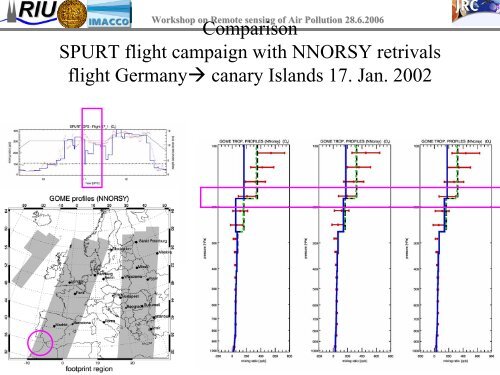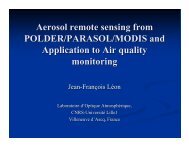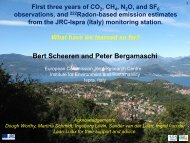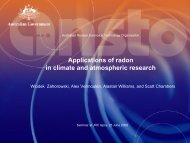Part 2
Part 2
Part 2
Create successful ePaper yourself
Turn your PDF publications into a flip-book with our unique Google optimized e-Paper software.
Workshop on Remote sensing of Air Pollution 28.6.2006Aerosol Chemistry in MADEModal Aerosol Dynamics forEURAD/Europe(Ackerman et al., 1998, Schell 2000)dM ik/dt=nuk ik+coag iik+coag ijk+cond ik+emi ikM ik:=k th Moment of i th ModeThe Future:Bridge from optical to chemicalpropertiesassimilation of aerosolBy sattelite retrievals: e.g.MERIS MODISAATSR+SCIAMACHY ,…
Workshop on Remote sensing of Air Pollution 28.6.20063Dvar aerosol assimilation (13.7.2003)in situ & SYNAER backgroundin situ & SYNAERin situ only
DateWorkshop on Remote sensing of Air Pollution 28.6.2006SYNAER data validation(and the problem with wildfires)# withheld RMS [μg/m 3 ] (improvement)stations no assim. In situ only In situ &satRemarks06.07.2003 - - - - no sat data07.07.2003 32 9.6 6.8 (29 %) 6.9 (28 %) wildfires08.07.2003 13 6.6 7.1 ( -8%) 6.7 ( -2%) wildfires09.07.2003 - - - - no sat data10.07.2003 27 9.3 6.5 (30%) 6.9(26%) wildfires11.07.2003 - - - - no sat data12.07.2003 29 1.9 1.4 (30%) 1.3 (32%) none13.07.2003 20 6.3 2.5 (61%) 1.9 (70%) none14.07.2003 49 7.3 5.5 (24%) 5.3(28%) wildfiresNeed for biomass burning detection, injection, and emission modelling
Workshop on Remote sensing of Air Pollution 28.6.2006General “State of the art problems”for data assimilation• tropospheric satellite data assimilation showmarginal to moderate performance incrementsafter DA for gas phase• more promising for aerosol phase• DA algorithms without optimality criterion (e.g.BLUE) and model integration are of minor value– useful if forecast improvements are visible– for monitoring purposes misleading
Workshop on Remote sensing of Air Pollution 28.6.2006Outlook (1)expected benefits from satellite retrievals• gas phase constituent retrievals are expected to bemost useful in “background” regions withcoarse or not existing in situ observations• with priority of populated areas (boundarylayer) aerosol retrievals appear to be most useful• merge as many satellite retrievals as possible,including meteorological (convective cloud)information, when proceeding to higherresolutions
Workshop on Remote sensing of Air Pollution 28.6.2006Outlook (2)for data assimilation algorithms• advanced DA algorithms proceed to limits with– non-Gaussian error characteristics– small convective scale dynamics• the smaller the scale, the tighter coupling to meteorologicalsimulations required• the aerosol composition problem will be a near futurechallenge (natural vs. anthropogenic)• the resolution dilemma:– coarse resolutions (~50 km) inadequate– fine resolutions (~5km):• much more expensive,• much more ill posed








